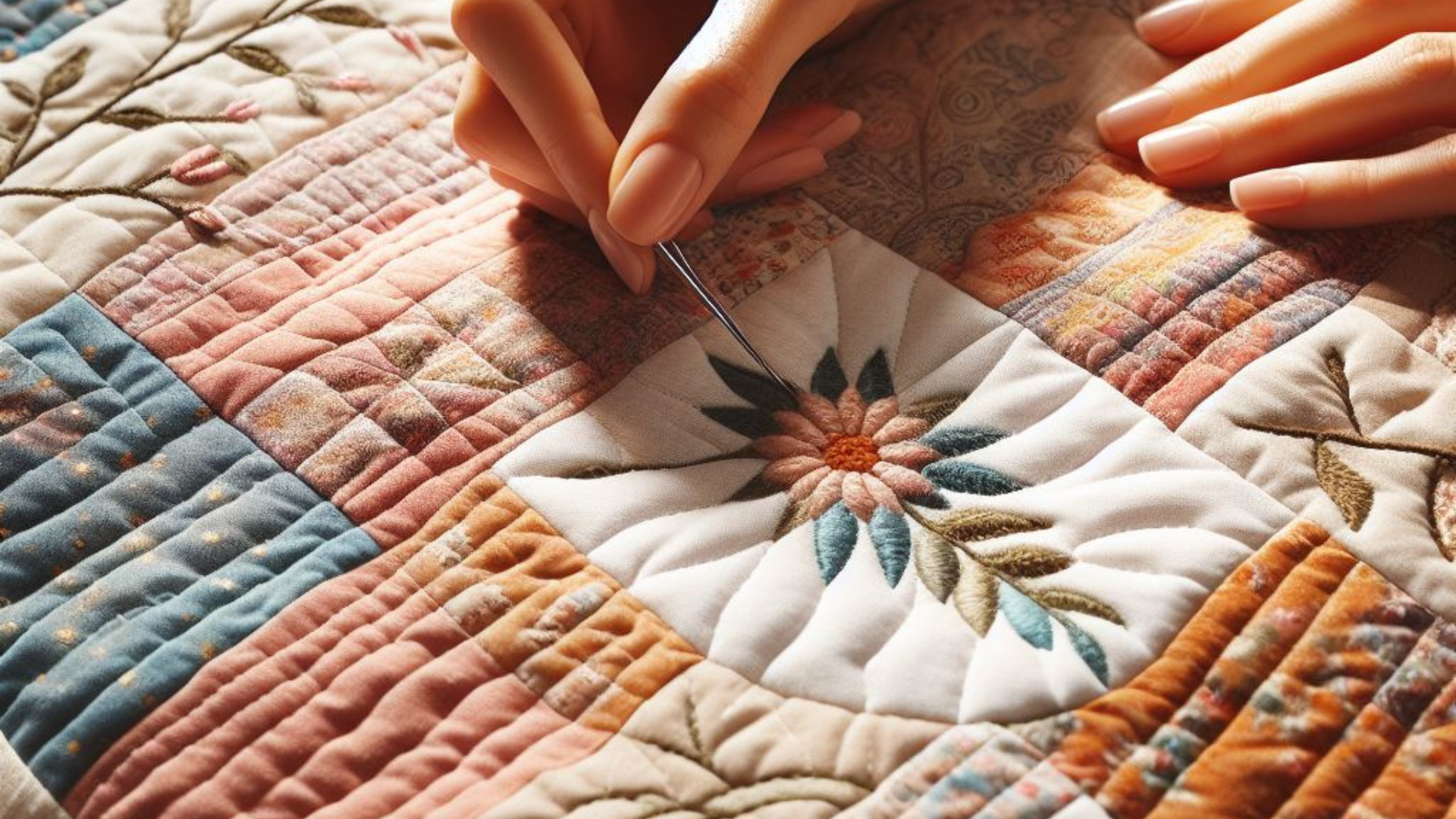Quilting is a delightful craft that allows you to weave together fabric, creativity, and skill into beautiful, cozy creations.
While templates are often used in quilting to ensure precision and uniformity, the art of free-form quilting opens a world of possibilities where templates are not a necessity.
What is Free-Form Quilting?
Free-form quilting, also known as improvisational quilting, liberates you from the constraints of templates. Instead of following predefined patterns, this technique empowers you to embrace spontaneity and creativity. It’s about embracing imperfections and allowing the fabric to guide your design.
Getting Started with Free-Form Quilting
1. Materials You’ll Need:
To start your free-form quilting journey, gather:
- Fabric scraps
- Sewing machine or needle and thread
- Cutting tools (scissors or rotary cutter)
- Batting
- Backing fabric
2. Choose Your Fabric:
Unlike traditional quilting that often requires precise cuts according to templates, free-form quilting lets you explore different fabric shapes and sizes. Mix textures, colors, and patterns for a unique aesthetic.

3. Start Small:
Begin with a small project like a mini quilt or a pillow cover. This allows you to experiment without feeling overwhelmed.
4. Design and Layout:
Lay out your fabric pieces organically. There’s no need to measure precisely or follow a specific pattern. Play with arrangement until you’re satisfied with the design.
5. Sewing Techniques:
Use a basic straight stitch or explore different stitches on your sewing machine. Seam allowances can vary, adding to the charm of the finished piece.
6. Embrace Imperfections:
Free-form quilting celebrates uniqueness. Embrace irregular shapes and sizes; they add character to your creation.
Benefits of Free-Form Quilting
- Unlimited Creativity: Without templates, you’re free to experiment with shapes, sizes, and designs, fostering your creativity.
- Personalized Touch: Each piece becomes a reflection of your individual style and artistic expression.
- Therapeutic and Relaxing: It’s a meditative process that allows you to enjoy the journey of creating without stressing over perfection.
So,…
Quilting without templates opens a world of artistic freedom. Free-form quilting is not about following strict rules but about expressing yourself through fabric. Embrace the beauty of imperfection and let your creativity flow as you embark on your quilting adventure.
External Resources:
- QuiltingHub – Free-Form Quilting Ideas
- Craftsy – Improvisational Quilting Techniques
- National Quilters Circle – Free-Form Quilting Tutorial
Moving forward
Remember, there are no rules in free-form quilting just endless possibilities waiting to be stitched together.
Overcoming Challenges in Free-Form Quilting
While free-form quilting offers boundless creative freedom, it can present challenges, especially for those accustomed to using templates. Here are some tips to navigate potential hurdles:
1. Managing Fabric Shapes:
- Tip: Embrace irregular shapes but maintain a balance to avoid excessive puckering while sewing.
2. Achieving Cohesiveness:
- Tip: Lay out your design and step back to assess the overall composition. Rearrange pieces if needed to create visual harmony.
3. Sewing Without Templates:
- Tip: Use fabric scraps as a guide for cutting similar shapes if needed. However, embrace variations for an organic look.
4. Quilting without Straight Lines:
- Tip: Experiment with free-motion quilting or organic lines to complement the free-form style.
Exploring Advanced Techniques
1. Art Quilting:
Dive into art quilting, where fabric becomes a canvas for expression. Explore mixed media, embellishments, and unconventional materials.
2. Improvisational Blocks:
Experiment with creating improvisational blocks, allowing you to piece together without predetermined shapes or sizes.
Final Thoughts
Free-form quilting is an exciting journey that encourages exploration and creativity. Embrace the uniqueness of your creations, and don’t be afraid to push boundaries and try new techniques. Remember, mistakes can lead to beautiful discoveries in this artistic endeavor.
External Resources:
- QuiltingHub – Free-Form Quilting Ideas
- Craftsy – Improvisational Quilting Techniques
- National Quilters Circle – Free-Form Quilting Tutorial
Feel free to explore these resources to further enrich your free-form quilting journey. Happy quilting, and may your creativity soar through every stitch.
Comparison tabular
| Aspect | Traditional Template-Based Quilting | Free-Form Quilting |
|---|---|---|
| Guidance | Follows precise templates/patterns | Allows creative freedom without templates |
| Fabric Cutting | Requires accurate cuts as per pattern | Embraces irregular shapes and sizes |
| Design Structure | Follows specific predetermined patterns | Encourages improvisation and spontaneity |
| Precision | Emphasizes accuracy and uniformity | Celebrates uniqueness and imperfections |
| Creativity | Limited by template constraints | Unleashes boundless creativity |
| Skill Level | Well-suited for beginners and experts | Challenges quilters to explore creativity |
| Approach | Follows set guidelines and rules | Embraces freedom and individual expression |
| Final Outcome | Often uniform and symmetrical | Offers unique, one-of-a-kind creations |
This table provides a succinct overview of the key differences between traditional template-based quilting and the more flexible, creative realm of free-form quilting. Both approaches have their merits, catering to different preferences and styles within the quilting community.
Wrapping up
In the world of quilting, whether you prefer the precision of templates or the artistic freedom of free-form quilting, the essence remains the same it’s about expressing yourself through fabric, stitches, and creativity.
Templates offer structure and uniformity, perfect for those seeking a guided, precise approach to quilting. On the other hand, free-form quilting celebrates uniqueness, embracing imperfections as part of the creative journey.
Ultimately, there’s no right or wrong way to quilt. It’s about finding joy in the process, whether you meticulously follow templates or let your imagination guide each stitch. So, pick up your fabric, thread your needle, and let your quilting adventure begin, whether on the structured path of templates or the boundless realm of free-form quilting.
Remember, in this world of quilting, every stitch tells a story, and every piece holds a piece of your heart and creativity. Happy quilting!

For over a decade, I’ve been Mike, an artist, crafter, and designer deeply immersed in the Croc world. I thrive on crafting unique, size-inclusive patterns, fostering creativity, and sharing them on ktforum.com. My designs aim to ignite your creative spark and delight you, ensuring clarity and ease of use through rigorous testing. Join me in expressing your creative flair and showcasing your craft with joy.
Related Posts
- Quilting Without a Quilting Hoop: Tips and Techniques
Quilting is a beautiful craft that allows you to create stunning and cozy pieces. While…
- Quilting with Flannel Fabric: Your Comprehensive Guide
Quilting is a beautiful craft that allows you to create cozy, functional, and artistic pieces.…
- Choosing the Best Thread for Quilting: A Comprehensive Guide
Quilting, an artful blend of precision and creativity, is not just about the fabric; the…
- Mastering Fabric Yardage Calculation for Quilting: Your Comprehensive Guide
Quilting is a delightful craft, but getting the fabric yardage right can be a puzzle.…

